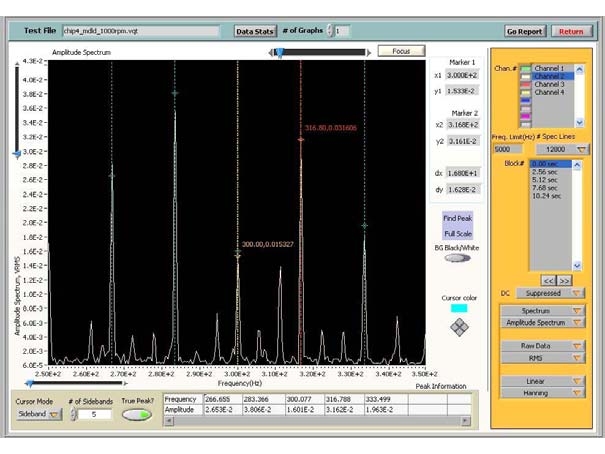VibraQuest
VibraQuest is an integrated data acquisition and analysis solution package designed for diagnosing rotating/reciprocating machinery malfunctions, structural dynamics analysis and acoustical analysis. This novel software includes proprietary advanced signal processing algorithms specially designed for diagnosing faults in drivetrain components such as gearbox, bearings and rotor cracks. It integrates with XLRotor and MEScope to solve noise and vibration problems, from experimental design to the final correction.
Noise and Vibration Solutions
Noise and vibration measurements and analyses are increasingly performed to enhance product quality; monitor and diagnosis rotating/reciprocating machinery performance; design more efficient structures and products; and improve our quality of life. In order to optimize the benefits, this process must be examined in a broad sense. Most software packages on the market today do not address each phase of the process needed to reach a complete solution. Typically, these phases are as follows:
- Project Definition and Experimental Design
- Data acquisition
- Data reduction and analysis
- Predictive model development
- Development of possible solutions and strategies
- Report generation
SpectraQuest’s VibraQuest starts the solution process by designing experiments. Then it helps you create a plan to implement the experiments. It collects quality data and performs in-depth analyses. VibraQuest also provides tools to quickly examine the effects of test variables to reveal root causes and develop a predictive model for arriving at solution strategies. Finally, the results can be used to create reports, which can be exported in a variety of different formats and shared with other engineers.
Features
- All inclusive turnkey platform for teaching the fundamental principles – from power generation to operation & maintenance
- An ideal package for enhancing an existing program or developing a new Wind Energy Technology program
- Fully integrated system with step-by-step instructions for experimentation and curriculum applicable to teaching several courses
- Planetary and parallel shaft gearbox designed for teaching condition monitoring and diagnostics
- Robust, modular, and easy to configure for a variety of experiments
- Can be operated with and without wind such as in laboratory settings
- Realistic system consisting of a nacelle, turbine hub, planetary and parallel shaft gearbox, three independently actuated blades, a vertical tower, wind speed/direction sensors, a control console and power measurement system
The WTS system has a spacious modular design featuring versatility, operational simplicity, and robustness. Each component is machined to high tolerances so it can be operated without conflicting vibration and other complications. The most comprehensive device of its kind on the market, the WTS is useful for a broad range of applications for wind energy education. It is an effective tool for training beginning maintenance professionals and offering experienced technicians a way to upgrade their job skills and improve performance.
Perfect Hands-on Training Tool for Wind Turbine Technician & Training Programs
The WTS gives a hands-on experience to students and can be integrated with the standard curriculum. Various experiments can also be performed to illustrate the theory and reinforce the learning of difficult principles. Some of the experiments, but not limited to, are listed below:
- Perform controlled experiments to learn the effects of various components on electric power production and the performance of a wind turbine
- Measure voltage & current and compute power as a function of wind speed, direction, and blade geometry
- Conduct aerodynamics experiments to study the effects of blade design, air speed and direction, blade angle of attack, etc on power production
- Perform assembly/removal operations to enhance maintenance and repair skills on electro-mechanical components of a wind turbine
- Learn to install and use different transducers such as accelerometers, wind speed sensor, wind vane, slip rings, gears, bearings, motors, generators, etc.
- Measure the vibration signature of drive train and turbine bearings for condition monitoring and diagnostics
- Perform tests with PC based blade pitch and yaw control system to learn their effects on power production and develop automatic controls for power optimization
- Develop power characteristics curves of a generator with different shapes and number of blades, wind speed and turbulence
- Measure blade lift and drag forces, drive shaft torque, and the tower tilt forces as a function wind speed/direction, blade pitch angle, and other parameters
- Teach concepts of energy storage, DC to AC conversion, and series-parallel combination of generator output for distribution of produced power.
VibraQuest comes in two variants: Lite and Pro. VibraQuest Lite provides all the functions for basic data acquisition and analysis, whereas VibraQuest Pro adds impulse data acquisition and additional, more advanced data analysis functions.
VibraQuest Lite:
- Multi-channel data acquisition and analysis system.
- Powerful signal processing and data presentations of time waveform, FFT spectrum, and frequency response function.
- Hanning, flat top and Kaiser-Bessel window functions
- Linear, log or dB scale.
- Magnitude, phase, real, or imaginary FRF.
- Two active cursors with delta values.
- Data statistics (mean, median, RMS, deviation, variance, correlation, covariance, etc)
- Two graphs can be used to compare between different files or channels.
- Simple project management, including experimental design with over thirty built-in templates to organize and document testing.
- User defined project and test templates for repetitive experiments.
- Capability to incorporate user-defined non-linear sensor behavior.
VibraQuest Pro adds:
- Impulse and hammer test data acquisition.
- Polar, Bode, Nyquist, orbit and waterfall plots.
- Cross power spectrum, coherence, and impulse response signal analysis.
- Additional window functions (Hamming, Blackman-Harris, exact Blackman, Blackman, 4 term Blackman, 7 term Blackman, force, and exponential).
- Octave analysis, 1 to 1/24 octave, linear, A, B, C weighting.
- Harmonics and sideband cursors.
- Up to eight graphs can be used to compare between different files or channels.
- Digital filtering.
- Multiple user management.
- Data import and export, including ME’scope for modeling and modal analysis.
- Data reporting.
For more advance analyses, a choice five modules can be added to VibraQuest Pro.
| Induction Motor Fault Diagnosis | Rotating Machinery | Data Streaming | Transient Analysis | Order Analysis |
Induction Motor Fault Diagnosis
Induction motors are the mostly used electrical driven system. Motor current signature analysis (MCSA) is a useful analysis and condition monitoring technique for the health of induction motors. With the Induction Motor Fault Diagnosis for VibraQuest, you can perform fault frequency calculation for diagnose problems, such as broken rotor bars, turn-to-turn shorts due to insulation breakdown, single phasing or loss of one phase, phase imbalance, both the static and dynamic eccentricity, and bearing defects. MCSA can detect these problems at an early stage and avoid consequent damage and catastrophic failure of the motor.
MCSA is the most widely used technique to analyze and monitor the health of induction motors. The Induction Motor Diagnosis module for VibraQuest provides five types of induction motor defects: broken rotor bar, stator short frequencies, static eccentricity frequencies, dynamic eccentricity frequencies, and mechanical influence frequencies. A graphical rendition of the fault with a detaied description is provided as well. Due to the complexity of the loading on induction motors, analysis is not often easy and the severity of defects is difficult to determine. This module also provides advanced signal processing tools such as demodulation for detecting malfunctions. Using the calculation templates, you can select the fault and display the fault frequencies an the spectra. Data can be viewed and exported in a variety formats. The software also allows you to compare motor current with vibration spectra.
Features
|
Benefits
|
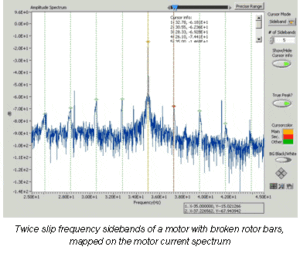 |
Envelope analysis
Airgap eccentricity, broken rotor bars, bearing damages, and time-varying load all cause sidebands in the current spectrum. Envelope analysis is a useful tool to detect these characteristic frequencies. The envelope analysis function in VibraQuest is based on an innovatively improved Hilbert transform method. This improved demodulation method attenuates the influences from high frequency contents and makes the envelope frequency easier to be identified.
Rotating Machinery
Rotating Machinery module for VibraQuest provides powerful tools for analyzing and diagnosing faults in rotating/reciprocating machinery. This module includes an extensive database of over 25,000 bearings from major manufacturers for calculating bearing faults. Fault frequencies associated with gearboxes, belt drives, pumps, fans, and other user-defined mechanical components can be calculated and displayed. You can also apply several advanced signal processing techniques for analysis and diagnosis.
Rotating machinery produces vibration signatures depending upon the mechanism involved. The purpose of analysis is to identify the forcing frequencies so that root cause can be addressed and corrective action can be taken. The Rotating Machinery module for VibraQuest has built-in template for calculating fault frequencies associated with various mechanisms of typical machinery.
Features
|
Benefits
|
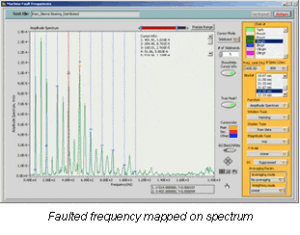 |
Fault frequencies
For rolling element bearings, when the rolling elements strike a local fault on the inner or outer race, or a fault on a rolling element strikes the inner or outer race, an pact is produced. The bearing frequencies can be dented as BPFO (ball passing frequency outer race), BPFI (ball passing frequency inner race), BFF (ball fault frequency), and FTF (fundamental train frequency). Using the Rotating Machinery module, rolling element bearing frequencies are specified from item loaded from database. Other available frequency categories include gearbox frequency, primary belt frequency, belt resonance frequencies, chain drive frequency, and fan blade pass/pump vane pass frequencies. Faulted frequencies can be mapped on the vibration spectrum.
Envelope analysis
Gearbox and rolling element faults generate amplitude modulation which causes sidebands in the spectrum. Envelope analysis is a useful tool for amplitude demodulation. The envelope analysis function in VibraQuest is based on an innovatively improved Hilbert transform method. This improved demodulation method attenuates the influences from high frequency contents and makes the envelope frequency easier to be identified.
Data Streaming
In many applications, it is important to collect data for long periods of time. Data Streaming module for VibraQuest allows you to capture, view and store long-duration and high-speed multi-channel data acquisition simultaneously. You also can use play-back panel to post-analyze the data with all the analysis functions and Parameters which are available for steady-state data analysis.
Sometimes we need to collect data for a long period of time before we can see transient phenomenon. Long-duration data acquisition is also important in automotive testing, machinery fault diagnosis and analysis. All the signals have to be continuously sampled at high speed to capture all the events associated with the test objectives. In order to ensure the fidelity of the data, it is necessary to display the data in some format while streaming and saving. The Data Streaming module can acquire data with speed up to 5 mega-samples/second. You can view multi-channel waveforms or spectra in real time. The captured data can be post-analyzed using the stream play functions which include time waveform, amplitude spectrum, frequency response function, coherence, orbit, and Bode plot. You can go through the data quickly using fast forward/reverse buttons, similar to those found on a tape recorder, or simply by dragging the lead cursors. The data segments are user-selectable, as is the block size for the FFT-calculation. All the time and frequency domain functions are available for data analysis. The data can be exported into universal ASCII format and ME’scope data format.
Features and Benefits
|
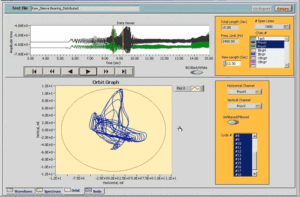 |
Transient Analysis
In structural dynamics, machine diagnostics, and many applications, a signal may be nonstationary. The Transient Analysis module for VibraQuest provides powerful tools to analyze the features of transient signals using joint time-frequency and wavelet transform. With our advanced analysis algorithms, you can view the power distribution of a time-dependent signal using variety of approaches, extract transient features, perform fast time-varying filtering, and reduce random noise.
The fast fourier transform (FFT) is the most widely used signal processing approach nowadays. However, the FFT has some drawbacks. First of all, the Fourier transform gives an averaged spectrum of a time signal over the entire time interval. A FFT-based spectrum can not detect the instantaneous frequency change, nor display how a frequency component evolves with time. A satisfied frequency resolution requires a long signal. Transient signals generally last in a very short time with fast frequency change, for example, engine knocks. For such a signal, the FFT spectrum is not able to catch the transient features, and the frequency resolution is low. In addition, if the fundamental frequency of a signal increases/decreases in time, the bandwidth of this frequency component in the FFT-spectrum becomes much wider than its real bandwidth. The faster the change of frequencies or amplitudes, the wider the bandwidth. During a starting-up or shutting-down test of a rotating machine, the bandwidth of the fundamental frequency and all the harmonics widens, which makes all the harmonics overlap in the frequency domain. Therefore the FFT spectrum is no longer able to distinguish the vibration caused by different source. Using advanced signal processing techniques, such as joint time-frequency and wavelet transforms, you can overcome the limitations of the FFT mentioned above.
Features
|
Benefits
|
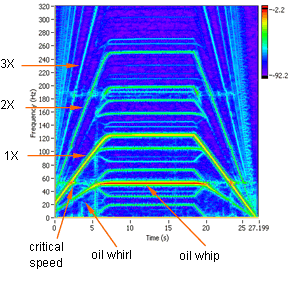 |
Clarify patterns of frequency changes
One major benefit of applying the Transient Analysis module to a signal is to discover the pattern of frequency changes, which often clarifies the nature of the signal. Once you identify a pattern, you can analyze and classify the pattern. The figure on the right shows the Gabor spectrogram of a signal obtained from a fluid-film bearing machine during a starting-up and shutting-down test. The horizontal and vertical axes are time and frequency, respectively. Different colors represent the power distribution. The frequencies associated with the running speed (1X) as well as the harmonics are clearly seen. When the running speed meets the first resonance frequency of the shaft, the energy reaches a maximum point. The oil whirl and whip are also clearly shown.
Time-Varying Filter
As mentioned above, different frequency contents of a transient signal may overlap in the frequency domain. You can use time-frequency analysis to distinct time-frequency components, perform time-varying filtering and reconstruct these components for further analysis. The figure below shows the procedure for a machine starting-up signal. On the time-frequency color map, the frequencies associated with the running speed and the harmonics, and the resonance quency of the bending vibration are clearly distinguishable. Three time-frequency components can be separated using three mask matrices. The random noise is amazingly reduced. Then the three components can be reconstructed to the time domain.
Order Analysis
Order analysis is a format of harmonic analysis specially designed for rotating or reciprocating machines. Order Analysis module for VibraQuest provides you powerful tools for rotating machinery diagnostics. With our advanced analysis algorithms you can perform RPM calculation, measurement of the power distribution in terms of RPM or frequency, extraction of any order component, measurement of the magnitude and phase of any order component, and examining signals in different presentation format.
Common mechanical phenomena in rotating/reciprocating machinery are related to the rotational speed of the shaft. In the conventional frequency analysis, a signal is sampled at instances with the fixed-time interval. However, the running speed of a rotating machine is generally not constant. Speed fluctuations are common in machines operating under load varying conditions. Sometimes it is important to examine the start-up or shut-down conditions. In these cases, the conventional frequency analysis produces significant spectral smearing or leakage, which makes it difficult to detect defects associated with various mechanisms. With tachometer, a signal can be sampled with fixed-angle interval, which avoids the problems mentioned above. Our Order Analysis module provides state-of-art Gabor expansion-based order analysis method, as well as resampling method or on-line order tracking.
Features
|
Benefits
|
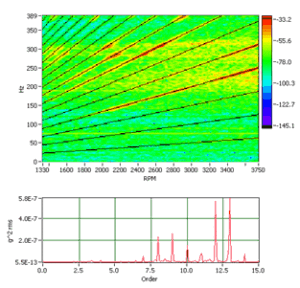 |
On-line Order Analysis and Data Acquisition
Our data acquisition (DAQ) system can measure digital/analog tachometer, ICP transducer, proximity probe and all standard industrial transducer signals. The DAQ devices possess high dynamic range (110/118 dB) and wide bandwidth (102/204 kHz). The on-line order analysis provides full capabilities to display the order spectrum, spectral map, waterfall, orbit, and Bode plots.
Tachometerless Order Analysis
For test environments where the tachometer is not available, the Gabor analysis-based order tracking allows you to compute the rotating speed information by performing some interactive operations on the spectral map.
Slow Roll Compensation
The slow roll vector can be automatically extracted from a low speed signal for slow roll compensation.
Functions
Order Analysis module allows you to perform the spectrum averaging in the following weighting modes: rms, vector, and peak hold. This module also provides order power spectrum, order magnitude, and order phase.
Displays
You can select the color maps and waterfall plots in the following formats: Frequency-RPM, Frequency-Time, Order-RPM. Order Analysis module also can display Orbit, Centerline, Bode, and Polar plots.
| Data Acquisition Software | |
| Steady State Mode | On-line time waveform, spectra, averaging, with assigned frequency limit, spectral lines, and number of blocks |
| Hammer Test Mode | On-line analyzer with double-hit rejection, trigger setting, pre-trigger sampling and force/exponential windows |
| Transient Test Mode | On-line order tracking with assigned start RPM, end RPM and RPM increment step |
| Analysis Functions | |
| Time domain analysis | Time waveform, windowing (Hanning, flat top, Hamming, Blackman, Blackman-Harris, exact Blackman, 4 term B-Harris, 7 term B-Harris, force, exponential) |
| Frequency domain analysis | Amplitude spectrum, power spectrum, spectral density, frequency response function, impulse response function, coherence, cross spectrum, averaging (RMS/vector/peak), linear and exponential weighting, linear/log/dB scaling |
| Cursor modes | Main cursor, secondary cursor, harmonic cursor, sideband cursor, true peak |
| Statistical analysis | Mean, RMS, standard deviation, variance, Kurtosis, median, mode, skewness, covariance, correlation, MSE |
| Data presentation | 1/2/4/8 window analysis, Bode, Nyquist, orbit plot, waterfall and polar plots |
| Acoustic analysis | Octave analysis, fractional octave analysis, frequency weighting (linear/A/B/C weighting), averaging (linear/exponential/equal confidence/peak), sound level meter |
| Digital Filter Design | Classical filter (Butterworth/ Chebyshev/ inverse CHebyshev/ Elliptic/ Kaiser window/ Dolph-Chebyshev window/ Equi-Ripple FIR), narrow band filter, notch/peak filter, comb filter |
| Add-on Modules | |
| Induction Motor Fault Diagnosis | Automatically identify induction motor fault frequencies and map on the spectrum; Choice of shorted turns, phase imbalance, single phasing, broken rotor bars, air gap eccentricity, and bearing defects |
| Rotating Machinery | Built-in template for calculating fault frequencies of bearing, gearbox, fan, belt, pump, and user-defined frequencies; database of over 25,000 bearings from major manufacturers; enveloping analysis |
| Data Streaming | High-speed multi-channel data streaming to hard disk; playback features include: back to beginning, fast rewind, last block, next block, fast forward, forward to the end; throughput rate: 5 mega-samples/second |
| Transient Analysis | Gabor analysis;short-time Fourier transform and reassigned STFT; analytic signal reduces cross-term interference in Wigner-Ville distribution; analytic wavelet scalogram; time-variant filter |
| Order Analysis | On-line order tracking; waterfall, color maps, orbit, centerline, Bode plot, polar plot; slow roll compensation |
| Balancing | Influence coefficient method, for-run method, trim balance method, for 1-plane and 2-plane balancing; interactive step-by-step operation provide on screen; maintain machine data and balancing history; slow-roll compensation |
| System Management | |
| Project management | Each project is deigned for a kind of test, which can be reused to simplify operation, assure consistency and same time. More than 30 built-in test templates are provided. |
| Reporting | Customize report into Microsoft Word, Excel, or HTML format |
| User management | Administrator manages multiple users who have individual tests and reports |
| Sensors and units | Common sensors and units are included. User can add/edit sensor type, sensitivity and unit. Non-linear sensitivity curve can be defined for polynomial curve-fitting routine. Both metric and English units are available. |
| Export formats | ASCII, ME�scope |
